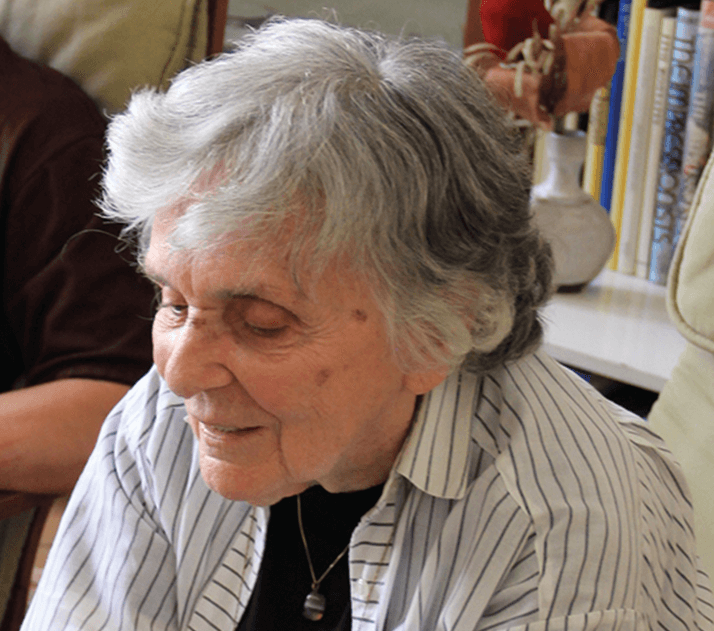
Take us back to the beginning... I was born on April 27, 1927. I grew up in the suburbs of Prague with my beloved parents. I had a happy childhood and enjoyed school until the Second World War and the occupation of my country. I spent the wartime in Theresienstadt, Auschwitz, Hamburg and, finally, Bergen-Belsen. After the liberation, the Red Cross took me to Sweden for medical treatment – but my dream was to return to Prague to resume my studies. My dream came true in November 1945.
What happened on your return?
I considered medicine given my experiences, but actually started studying chemistry at Charles University in Prague. It was a great decision – and I’ve never regretted it. The first step of my scientific career was in the field of polarography, studying complex formations that could separate otherwise inseparable ions. During those early years, I was lucky to meet and befriend such personalities as Jaroslav Heyrovsky, who won the Nobel Prize in Chemistry for his discovery
of polarography.
How did you start in gas chromatography? In the early 1950s, a volumetric chromatographic device grabbed my attention at an analytical conference in Prague. We started to prepare our own device with volumetric detection. Next, we constructed a glass thermal conductivity detector, which was more universal and allowed us to analyze a larger variety of gas. At the time, it was a new idea, but I wasn’t aware of that fact! Soon after, this detector became part of a commercially available instrument.
Where did that lead you? In the early 1970s, I studied inclusion complex formations in selective analytical separations. Our first choice was cyclodextrins, but they weren’t available, so we began with urea and thiourea for the separation of isomers. Thanks to József Szejtli, we were able to start research on cyclodextrins relatively soon after in GC, HPLC, and modern electromigration methods. Actually, I think we were the first to use cyclodextrins in isotachophoresis. Our research became popular, and we were asked to contribute several monographs on cyclodextrins – one that stands out in my mind was for a compendium on supramolecular chemistry edited by another Nobel Prize winner: Jean-Marie Lehn. Cyclodextrins are also responsible for my friendship with Dan Armstrong; it’s a pleasure to follow his research.
Who were your other heroes? In the 1950s (when I’d moved over to GC) there is no doubt that A. I. M. “Lou” Keulemans (Eindhoven University of Technology) had a huge influence on both my scientific and personal life. He put me in touch with a lot of other big names around the world. In 1968, he started an initiative called the Scientific Exchange Agreement, which enabled cooperation between laboratories in East and West Europe – a very special and significant development. In 1975, we married and he spent the last two years of his life with me in Prague. A. A. Zhukhovitskii was also very important in my life. And over the years, I got introduced to many other great scientists. I knew J. J. van Deemter and Erika Cremer, and at Eindhoven University I spent a lot of time with A. J. P. Martin – Nobel Prize winner in chromatography. To be honest, I have a very long list of impressive people who I am proud to have called friends.
What motivated scientists in the 1950s? It was a very special time. Many universities got closed during the war, but – like me – many young people were excited to resume studies. It’s fair to say that there was a lack of instrumentation; however, there was a great deal of enthusiasm! We had to rely on home-made instruments and do research with simple equipment. I remember visiting Professor Willy Simon’s lab at the University of Zurich and being amazed by the number of instruments. He told me, “Yes, instruments are important. But you can do chemistry with very simple equipment.” Indeed, ideas are sometimes more powerful. I think scientific knowledge was higher back in my day – I think solving problems with minimal facilities demands a deeper understanding. Today, we have fantastic instruments and results are produced very quickly – but the ideas are sometimes very old! I’m surprised when I hear about research that we did 50 years earlier... It’s important to remember that modern science can benefit from a sound knowledge of historical research. Progress and advances that may have been forgotten could aid in a new discovery.
What else would you say to the younger generation? I returned from my bad experience in the war with a key philosophy: my eyes are in the front of my head, therefore, I need to look towards the future. That’s helped me throughout my whole life. From my personal experience, I know that building relationships is not just a question of a mutual exchange of ideas; I gained a great deal of pleasure from the long-term friendships I forged with other scientists. And that includes students – who later saved me from the feeling of getting old! I learned from Berzelius (the well-known 19th Century Swedish chemist) the important role that fantasy plays in science. It is often the way to new ideas. Finally, I remember Zhukhovitskii’s closing remarks at a Moscow symposium in 1959: “Gas chromatography is an excellent method to separate substances, and an excellent way to unite people.”




